
|
|

 September 26, 2008
September 26, 2008
WAER, Syracuse, NY
So we're all done with our recap of Big Trip 2007 - and just a few weeks ago, a big pile of boxes of Tower Site Calendar 2009 came back from the printer, all ready for sale and for your office or transmitter shack wall. We hope you'll take a moment to get your order in for the calendar, or better yet, show your support for Site of the Week and NorthEast Radio Watch with a subscription!
This week, we move on to some sites that aren't in the calendar, but are well worth a feature here on Site of the Week.
For instance, how about the first class D educational station in the country?
That's the distinction WAER (88.3) at Syracuse University claims, with a history that goes back to 1947 and an experimental 2.5-watt license under the calls WJIV. This wasn't the university's first venture into broadcasting - in the twenties and thirties, it had operated WSYU, a "phantom station" that used the facilities of commercial station WSYR (570) to broadcast sporting events and lectures. It was, however, the start of something new - a low-power, low-cost option for student broadcasters to get on the air at colleges and high schools all over the country.
In 1948, the FCC made Class D an official part of the FM licensing scheme, and it was around that time that little WJIV took the calls WAER, for the Alpha Epsilon Rho honor society. The student-run station, operating from a prefab building hastily erected during the university's post-war boom, gradually increased power to 3500 and then to 6000 watts, and by the seventies had moved its studios to the newly-built Newhouse II building, part of the Newhouse School of Public Communications.
1983 brought big changes to the station, as the student-run freeform programming was replaced by professionally-operated public radio, heavy on jazz and news. (That story is chronicled, from one point of view, anyway, at this website, which also features pictures of the Newhouse studios.)
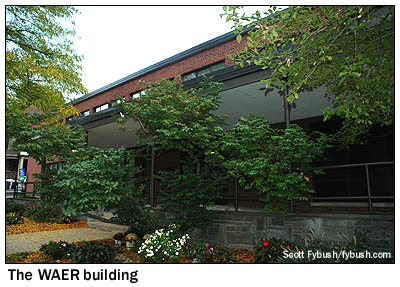 |
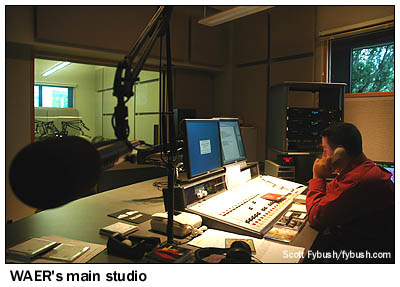 |
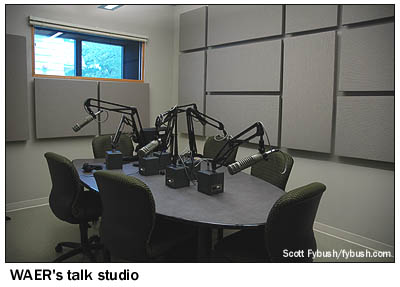 Soon
afterward, WAER raised power to 50 kW, and in 2003, the station
moved out of its cramped Newhouse quarters and took over Haft
Hall at 795 Ostrom Avenue, on the edge of the campus.
Soon
afterward, WAER raised power to 50 kW, and in 2003, the station
moved out of its cramped Newhouse quarters and took over Haft
Hall at 795 Ostrom Avenue, on the edge of the campus.
The building had been built in 1955 as a dorm, and was later used as a sorority hall, but WAER's arrival brought a massive renovation, from the basement (which had housed a lounge and bar that was converted into a staff/volunteer lounge, as well as utility rooms that now serve as engineering rack rooms and a shop area), to the first floor (now home to business offices and a newsroom for the student news and sports staff), to the second floor, where dorm rooms became offices.
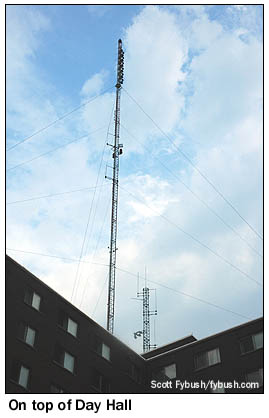 To the
right of the lobby, the building was gutted to create a high-ceilinged
space for studios - a talk studio, a main air studio, and a news
booth looking into the main air studio.
To the
right of the lobby, the building was gutted to create a high-ceilinged
space for studios - a talk studio, a main air studio, and a news
booth looking into the main air studio.
(Yes, the console is a Wheatstone, from the days when Wheatstone made its boards at a factory just down the road from the university.)
It's only a few hundred yards from the Ostrom Avenue studios to WAER's transmitter site, a tower on the roof of the Day Hall dormitory - but they call the area where Day Hall is located "Mount Olympus" for a reason.
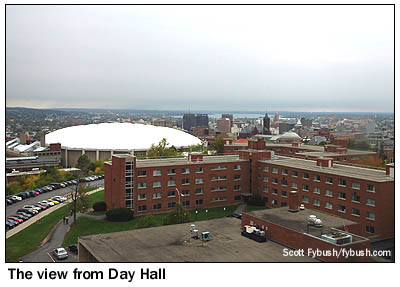 It's
a steep hike - or a quick drive, in our case - up the road to
the cluster of dorms up on Mount Olympus, and in exchange for
the workout, residents up here enjoy a panoramic view of Syracuse,
from downtown and Onondaga Lake to the northeast across to the
hills of Sentinel Heights to the south. (We profiled some of
those sites last
year in this space.)
It's
a steep hike - or a quick drive, in our case - up the road to
the cluster of dorms up on Mount Olympus, and in exchange for
the workout, residents up here enjoy a panoramic view of Syracuse,
from downtown and Onondaga Lake to the northeast across to the
hills of Sentinel Heights to the south. (We profiled some of
those sites last
year in this space.)
Up on the roof of Day Hall, a mechanical penthouse is home to two cages of transmitter equipment. One houses the old CCA and newer Harris transmitters for WAER - and, yes, they're running HD Radio here now, with 88.3-HD2 carrying the "XPoNential Radio" programming from Philadelphia's WXPN, a welcome burst of AAA in a market lacking such a format.
The other cage - not shown here - has the transmitter for the student station, WJPZ (89.1). WJPZ has an interesting history of its own: it started as a carrier-current AM in the mid-seventies, programming a tightly-formatted top-40 sound that contrasted with WAER's freeform vibe. In 1985, it moved to FM, running 100 watts from an antenna low down on that short Day Hall tower.
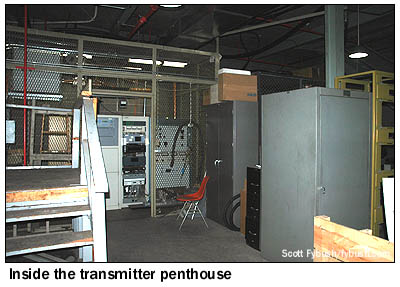 |
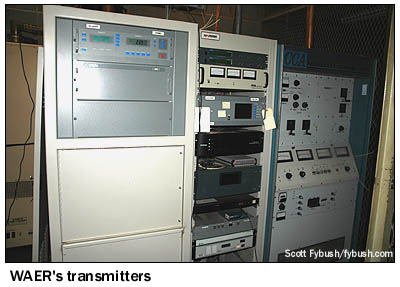 |
One more note before we move on - the interplay between 88.3 and 89.1 in this densely-populated area caused some mixing-product issues for another regional public radio station, WRVO (89.9) in Oswego - and that's why WRVO operates a low-power relay transmitter, WRVD (90.3) atop a hospital building just down the hill from Mount Olympus.
- Previous Site of the Week: Finger Lakes
- Next Week: WSEN and WFBL, Syracuse
- Site of the Week INDEX!
- How can you help support Site of the Week? Click here!
- Submit your suggestions for a future Site of the Week!
